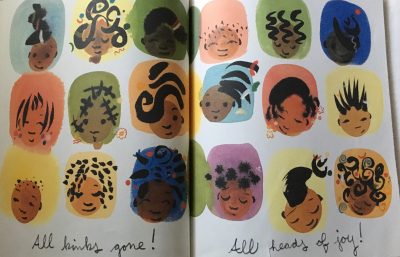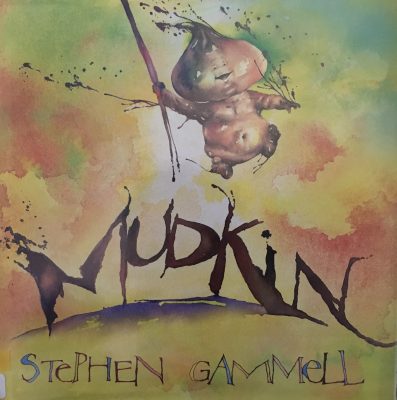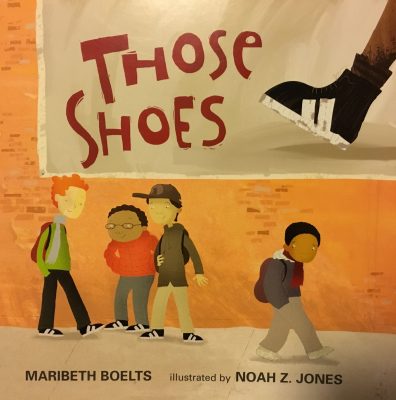Author: Patricia Polacco
Illustrator: Patricia Polacco
Publisher and Year: Aladdin, 2001
Number of pages: 32 pages
Genre: Picture Book
The Keeping Quilt tells the story of a handmade quilt and a remarkable family. This quilt was made of Uncle Vladimir’s shirt, Aunt Havalah’s nightdress, Aunt Natasha’s apron, neighbor’s flowers and animals from scrap of clothing, great grandmother Anna’s babushka and old dress. It has been made and kept across six generations, along with love growing and time passing.

The author, who is also the illustrator, used two and six B pencils and acetone markers for the illustrations. The story starts when the author’s great grandmother Anna came to America and lived in New York City. The street looks very crowded with people across two pages who are minding their own business. Everything is black and white except Anna’s babushka which is bright red. Anna sits in the crowd, holding her umbrella, and her face seems to be absent from emotions. Some people look happy and are talking with each other.
Everything continues to be black and white except this babushka and later the quilt. When Anna went to school and started learning English, she seems scared in the picture. She stands in the left corner, looking down on the ground while other children try to talk to her. Then we see Anna alone dancing and swirling with her babushka up in the air. She seems very happy and free. We see three Annas in the picture which implies she is moving around.
Later the quilt was made. Anna, Anna’s mother and their neighbors sit around a big table. Everybody seems calm and immersed in their work. The quilt looks beautiful. The quilt was then passed on in the family and was used for various purposes. Each page contains a different event. In the end, the author is holding her baby girl Traci Denise. She believes someday Traci will leave home and take the quilt with her.
This beautiful quilt served as a window which helps us peek through this long family history. It leads us back in time to see the changes of the culture of society. When Anna and Sasha got married, men and women celebrated separately. When grandmother Carle and Grandfather George got married, men and women celebrated together but they still did not dance together. When the author’s mom and dad got married, friends who were not Jews came to the wedding. One thing that hasn’t changed is the family tradition of keeping things like gold, bread, and salt in the bouquet. Like the author said, “It is a wonderful way to not only introduce my remarkable family, but also demonstrate their personal triumphs, disappointments, and their ever-powerful love that has reached across six generations and an ocean of time.”



 throughout the scenes where the reader seems to be viewing the actions of the characters from afar. The illustrations allow the reader to peer through a window into this time period of racism in the South. They have the reader feel the emotions of the main character during her trip to town. Thus there is a connection of empathy toward and fear for the young girl.
throughout the scenes where the reader seems to be viewing the actions of the characters from afar. The illustrations allow the reader to peer through a window into this time period of racism in the South. They have the reader feel the emotions of the main character during her trip to town. Thus there is a connection of empathy toward and fear for the young girl. 






 allowing the reader to look into another world of the past. It lets the reader peer into the lives and feel the emotions of the characters during their journey. There are throughout the book small illustrations that are present on the pages that contain the text. They are always images of the train traveling to its next stop, which shows the scenery and setting of the locations.
allowing the reader to look into another world of the past. It lets the reader peer into the lives and feel the emotions of the characters during their journey. There are throughout the book small illustrations that are present on the pages that contain the text. They are always images of the train traveling to its next stop, which shows the scenery and setting of the locations. 


 allow the reader to peer through a window into the lives of the characters as their experiences may be different than many other people. The images share the emotions and worries of the characters with the reader as there is a connection through the illustrations.
allow the reader to peer through a window into the lives of the characters as their experiences may be different than many other people. The images share the emotions and worries of the characters with the reader as there is a connection through the illustrations. Author: Rose Blue and Corinne J. Naden
Author: Rose Blue and Corinne J. Naden

 of the characters. It lets the reader peer into the experiences and journeys the characters endured during this time period of immigration. The illustrations create a window effect for the reader to look into a world of the past. The reader seems to always be watching the character’s from afar due to the bordering of the illustrations. There are illustrations that are from present time where the grandfather is talking to the young girl. These images are bordered by the edges of the page rather than thick lines. The changes of imagery show the reader the change in the time periods. There are small illustrations that are present on the pages that contain the text. These are always images of the matchboxes and the items that are placed inside during the grandfather’s journey.
of the characters. It lets the reader peer into the experiences and journeys the characters endured during this time period of immigration. The illustrations create a window effect for the reader to look into a world of the past. The reader seems to always be watching the character’s from afar due to the bordering of the illustrations. There are illustrations that are from present time where the grandfather is talking to the young girl. These images are bordered by the edges of the page rather than thick lines. The changes of imagery show the reader the change in the time periods. There are small illustrations that are present on the pages that contain the text. These are always images of the matchboxes and the items that are placed inside during the grandfather’s journey.